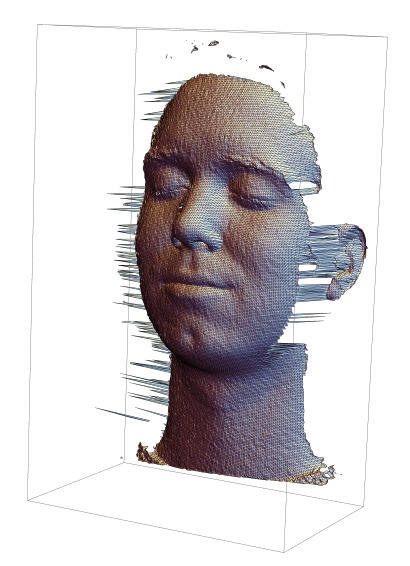Scanner 3D à lumière non structurée non synchronisé
memoire » M.Sc.Chaima El Asmi
Tags: Computer vision , Active reconstruction , Unstructured light , Unsynchronized camera-projector systems , Subpixel accuracy , 3D scanning
Date : 2018-08
Papyrus
http://hdl.handle.net/1866/22126Abstract
 This thesis in the field of computer vision and specifically focuses on active reconstruction methods. Firstly, it proposes a new approach to structured light correspondence which alleviates the camera-projector synchronization problem. This allows the creation of a dense correspondence map between the camera and projector which can further be used to obtain 3D models. This high-speed approach is ideal for scanning human faces, which are notoriously difficult because of involuntary motions of the subjects. Secondly, it proposes an improvement to the matching accuracy by aligning, to high subpixel precision, the respective neighborhood patches of each pixel. Thirdly, an example of an application of the method is proposed. Until now, great care was required to make sure that each camera image was captured exactly when the correct pattern was projected. This was difficult to achieve with low-cost hardware or large size installations. In our method, the projector sends a video loop of a selected number of unstructured light patterns at a high frame rate (30 to 60 fps for common hardware), which are captured by a camera without any form of synchronization. The only constraint to satisfy is that the camera and projector frame rates are known. The matching process not only recovers the correct pattern sequence, but is robust to partial exposures of consecutive patterns as well as rolling shutter effects. Through these steps, the crucial camera-projector synchronization problem is entirely taken care of. Subpixel matching accuracy is obtained by relying on image interpolation to refine the original correspondences. These results are highly accurate and comparable to other state-of-the-art subpixel methods but with better robustness. The obtained results illustrate 3D models reconstructed with very high precision in difficult conditions such as indirect illumination, scene discontinuities, and use of low quality hardware. The last part of this thesis is devoted to the description of the design and manufacturing of a customized virtual reality headset which snuggly matches a user’s face, thanks to 3d models constructed from the matching method proposed in the thesis, where high quality is obtained on low-cost hardware.
This thesis in the field of computer vision and specifically focuses on active reconstruction methods. Firstly, it proposes a new approach to structured light correspondence which alleviates the camera-projector synchronization problem. This allows the creation of a dense correspondence map between the camera and projector which can further be used to obtain 3D models. This high-speed approach is ideal for scanning human faces, which are notoriously difficult because of involuntary motions of the subjects. Secondly, it proposes an improvement to the matching accuracy by aligning, to high subpixel precision, the respective neighborhood patches of each pixel. Thirdly, an example of an application of the method is proposed. Until now, great care was required to make sure that each camera image was captured exactly when the correct pattern was projected. This was difficult to achieve with low-cost hardware or large size installations. In our method, the projector sends a video loop of a selected number of unstructured light patterns at a high frame rate (30 to 60 fps for common hardware), which are captured by a camera without any form of synchronization. The only constraint to satisfy is that the camera and projector frame rates are known. The matching process not only recovers the correct pattern sequence, but is robust to partial exposures of consecutive patterns as well as rolling shutter effects. Through these steps, the crucial camera-projector synchronization problem is entirely taken care of. Subpixel matching accuracy is obtained by relying on image interpolation to refine the original correspondences. These results are highly accurate and comparable to other state-of-the-art subpixel methods but with better robustness. The obtained results illustrate 3D models reconstructed with very high precision in difficult conditions such as indirect illumination, scene discontinuities, and use of low quality hardware. The last part of this thesis is devoted to the description of the design and manufacturing of a customized virtual reality headset which snuggly matches a user’s face, thanks to 3d models constructed from the matching method proposed in the thesis, where high quality is obtained on low-cost hardware.